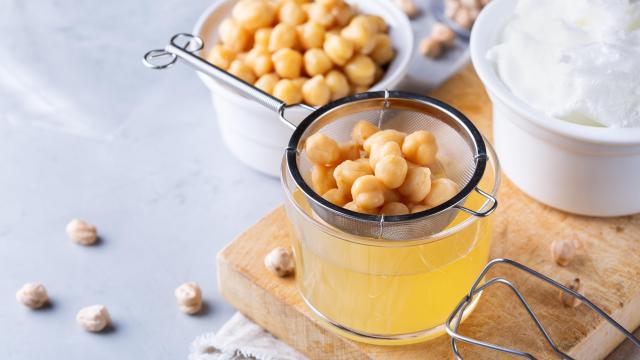When it comes to chickpeas and aquafaba, the liquid and the legume are two very different residents of the same can. Just because you used garbanzo beans in your salad doesn’t mean that you’re craving these fluffy pancakes on the same day (but you might on Saturday). In the event that you have leftover aquafaba — or really any time you’re eating chickpeas and find yourself about to drain out the liquid — stop your hand. It freezes incredibly well.
Aquafaba has gained a lot of traction since it was discovered in 2014 as being a surprisingly effective replacement for whipped egg whites (read more about the history here). However, it has more applications than being a pavlova party trick. It’s an excellent vegan ingredient that can thicken soups or bind and aerate baked goods, like muffins and the aforementioned fluffy pancakes.
I’m not vegan, and I use eggs in most of my baking, but I do often use aquafaba to thicken soups and sauces. It has some similar components to eggs, like albumins and globulins, and its starches give soup stocks added viscosity. It took some practice for me to stop draining my chickpeas, but I’ve built up a habit of freezing the leftover aquafaba. Whenever I happen to be making soup and the broth could use a little somethin’, I can easily turn to my freezer.
America’s Test Kitchen suggests freezing the stuff in ice cube trays, but I usually only freeze one can’s worth at a time, and slightly less than half a cup is not enough to command a whole tray. Instead, I freeze the aquafaba in a small plastic container (approximately a 113.40 g square), and then I tap out the brick into a freezer bag for longterm storage. Sometimes I’ll have two or three cubes in there at a time, ready for my next soup or sauce. If you decide to divide it up into an ice cube tray, be sure to whisk or lightly shake the chickpea liquid before pouring. Aquafaba is not naturally homogenous, so this helps to evenly distribute those albumins and globulin particles before freezing.
Aquafaba keeps frozen for up to four months. If you’re worried about the aquafaba not performing as well after it’s had some time in the ice chest, put your fears to rest. Freezing does not destroy or impair the starches that are responsible for its excellent whipping abilities, and according to America’s Test Kitchen, the frozen and thawed version works just as well as before. Thaw aquafaba by putting cubes in a bowl in the fridge overnight or by microwaving for a minute or two, depending on how large the cube is. If you’re using it in a soup or sauce, simply throw a frozen slab directly in the pot with everything else.

Leave a Reply
You must be logged in to post a comment.